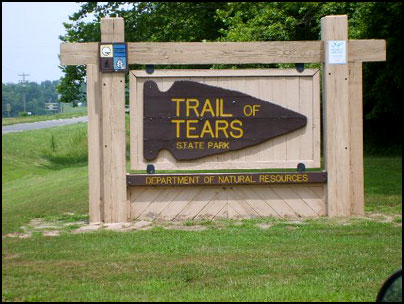 In 1830 the US Congress, at the behest of President Andrew Jackson, passed the “Indian Removal Act.” With this act, the US intended to remove all Indian people to Indian Territory, land west of the Mississippi River. The majority of the Cherokee people opposed removal, but a small group of Cherokee known as the Treaty Party gathered in secret to sign the Treaty of New Echota, which ceded the Cherokee Nation lands in return for land in Indian Territory. The treaty was illegal according to Cherokee law, but was recognized by the US government. Most of the Cherokee remained in their homeland, not believing that the US government had the right or the power to forcibly remove them.
In 1830 the US Congress, at the behest of President Andrew Jackson, passed the “Indian Removal Act.” With this act, the US intended to remove all Indian people to Indian Territory, land west of the Mississippi River. The majority of the Cherokee people opposed removal, but a small group of Cherokee known as the Treaty Party gathered in secret to sign the Treaty of New Echota, which ceded the Cherokee Nation lands in return for land in Indian Territory. The treaty was illegal according to Cherokee law, but was recognized by the US government. Most of the Cherokee remained in their homeland, not believing that the US government had the right or the power to forcibly remove them.
In May 1838, General Winfield Scott and a command of 7,000 men arrived in the Cherokee Nation to remove the Cherokees from their homes and force them west. This event later became known as the Trail of Tears, or the Trail Where They Cried, where thousands of Cherokee perished.
The Trail of Tears State Park is located on the site where nine groups of Cherokees crossed the Mississippi River in harsh winter conditions along the Trail of Tears. This site was along the “Northern Route” which took the Cherokee north through Nashville, Tennessee; Hopkinsville, Kentucky and into southern Illinois and Missouri before swinging south to Indian Territory (present-day Oklahoma). Groups traveling on this northern route numbered from several hundred to nearly 2,000 in one case. All told, nearly 12,000 Cherokee started the journey on this route, but fewer than 10,500 arrived in Indian Territory (including births along the way).
Many people died along the way, and in this area the difficult weather would create delays and issues with crossing the Mississippi River. Today there is a memorial for a “Princess Otahki, daughter of Chief Jesse Bushyhead” which is a well-intentioned memorial to honor those Cherokee who died on the Trail. Unfortunately, the details of the memorial are not correct. First, the Cherokee did not use terms of royalty. There were no Cherokee Princesses. Additionally, there was no Chief Jesse Bushyhead. Jesse Bushyhead was actually a Reverend and he led a detachment of Cherokee along the Trail (perhaps lending confusion as to his role within the tribe). It was not Jesse, but rather his son Dennis Bushyhead who would become Principal Chief in 1879.
 Photos Copyright Stephanie Chapman, used with permission.
Photos Copyright Stephanie Chapman, used with permission.
Trail of Tears State Park Travel Details
The park grounds are open daily.
Directions: The Trail of Tears State Park is just north of Cape Girardeau, Missouri. For specific directions, click the “Directions” link in the location bubble of the map above and enter your starting location on the left.
GPS & Map: 37.44433544620038,-89.46990966796875